 Polar Coordinates (Part 1)
Polar Coordinates (Part 1)
(This page is Part 1. Click here for Part 2. Click here for Part 3.)
Roughly, polar coordinates determine the position of a point in a plane by specifying a distance from a fixed point in a given direction.
- What is a Coordinate System?
- ‘Graph Paper’ for the Rectangular versus Polar Coordinate Systems
- Definition of Polar Coordinates
- Examples: Plotting Points in Polar Coordinates
- Non-Uniqueness of Polar Coordinates
- Simple Curves in Polar Coordinates (in Part 2)
- Converting from Polar Coordinates to Rectangular Coordinates (in Part 2)
- Converting from Rectangular Coordinates to Polar Coordinates (in Part 3)
- Flowers, Spirals, and More (in Part 3)
What is a Coordinate System?
Pick a point in a plane. (Think of a dot on a piece of paper.) A coordinate system is used to answer these questions:
‘Where is this point?’
or
‘How do you get to this point?’
A coordinate system always involves:
- A starting place (i.e., some sort of ‘origin’)
- Rules for how to move from the starting place
Depending on what you're doing, one type of coordinate system might be much simpler to use than another!

Radar systems are well-suited to polar coordinates
As you'll see, applications involving concentric circles (circles with a common center) are probably going to be much better suited to polar coordinates (this section) than to the (more familiar and widely-used) rectangular coordinates.
‘Graph Paper’ for the Rectangular versus Polar Coordinate Systems
It's fun (and instructive) to compare the ways the plane is ‘divided up’ for rectangular versus polar coordinates. A more precise discussion of polar coordinates follows.
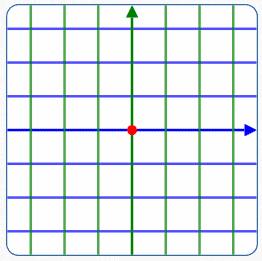
Rectangular/
Coordinate System
To plot a point:
- Start at the origin
- Move left/right a specified amount ($\,x\,$)
- Move up/down a specified amount ($\,y\,$)
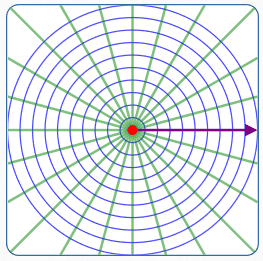
Polar Coordinate System
To plot a point:
- Position the starting ray; the endpoint is called the ‘pole’
- Rotate the ray a specified angle ($\,\theta\,$)
- Move from the pole in the new direction a specified amount ($\,r\,$)
Definition of Polar Coordinates
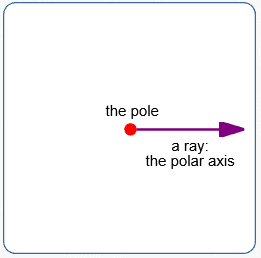
A polar coordinate system is determined by:
- A plane
-
A ray in the plane:
- The ray is called the polar axis
- The endpoint of the ray is called the pole
Conventionally, the ray is horizontal, pointing to the right.
Let $\,r\,$ (the radius) and $\,\theta\,$ (the angle) be real numbers. If $\,\theta\,$ has no units, then it is the radian measure of an angle. Other units (like degrees) can also be used for $\,\theta\,.$
To determine the position of the point with polar coordinates $\,(r,\theta)\,$:
Direction ($\,\theta\,$)
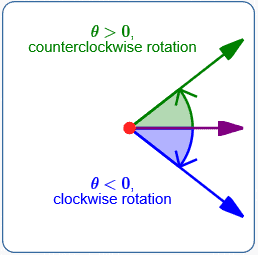
Rotate the polar axis about the pole by an amount $\,|\theta|\,$:
- For $\,\theta \gt 0\,,$ rotate counterclockwise (green ray above).
- For $\,\theta = 0\,,$ there is no rotation.
- For $\,\theta \lt 0\,,$ rotate clockwise (blue ray above).
For convenience, call this the rotated ray.
Directed Distance from Pole ($\,r\,$)
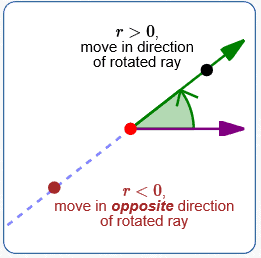
Move from the pole a distance $\,|r|\,$:
- For $\,r \gt 0\,,$ move in the direction of the rotated ray.
- For $\,r = 0\,,$ do not move.
- For $\,r \lt 0\,,$ move in the opposite direction of the rotated ray.
Summary: Polar Coordinates $\,(r,\theta)$

Starting set-up for a polar coordinate system

Rotate the polar axis about the pole by an amount $\,|\theta|$

Move the point from the pole a distance $\,|r|$
Notes on Polar Coordinates
Infinitely Many Names for the Pole
For any angle $\,\theta\,,$ the polar coordinates $\,(0,\theta)\,$ gives the pole. In other words, if the radius is zero, then—regardless of the angle—you get the endpoint of the polar axis.
Distinguish Between Rectangular and Polar Coordinates
If you're using both rectangular and polar coordinates in the same discussion, then you need a way to distinguish between the two. One easy way (without introducing any new notation) is to always say something like ‘$\,(x,y) = (1,2)\,$’ versus ‘$\,(r,\theta) = (1,2)\,$’.
What Does ‘$\,r = 3\,$’ Really Mean?
When you say something like ‘$\,r = 3\,$’ there is an implied understanding of a known unit. That is, $\,r\,$ is $\,3\,$ what? Here are two approaches you can take:
- You can agree that the polar axis ‘carries’ the units. In this case, the polar axis acts like (half of) a number line.
- You can agree that $\,r = 3\,$ means that $\,r\,$ is (say) $\,3\,$ centimeters. Of course, any unit of length can be used.
Examples: Plotting Points in Polar Coordinates
In all these examples:
- The polar axis is purple
- The rotated ray is faded purple
- The red circle has radius $\,2\,$; its center is the pole
- The point with polar coordinates $\,(r,\theta)\,$ is shown in green
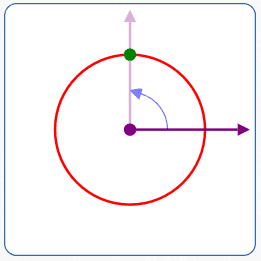
$r = 2$
$\theta = 90^\circ$
- Rotate the polar axis $\,90^\circ\,$ counterclockwise
- Move $\,2\,$ units in the direction of the rotated ray
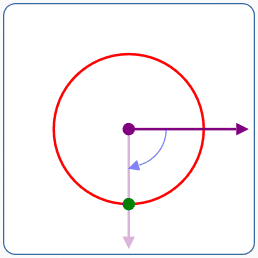
$r = 2$
$\theta = -90^\circ$
- Rotate the polar axis $\,90^\circ\,$ clockwise
- Move $\,2\,$ units in the direction of the rotated ray
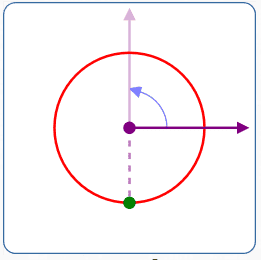
$r = -2$
$\theta = 90^\circ$
- Rotate the polar axis $\,90^\circ\,$ counterclockwise
- Move $\,2\,$ units in the opposite direction of the rotated ray
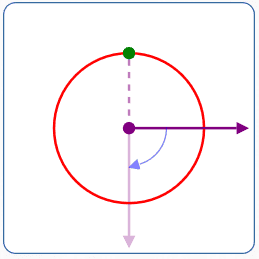
$r = -2$
$\theta = -90^\circ$
- Rotate the polar axis $\,90^\circ\,$ clockwise
- Move $\,2\,$ units in the opposite direction of the rotated ray
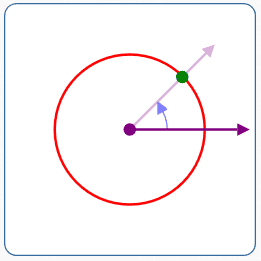
$r = 2$
$\theta = \pi/4$
- Rotate the polar axis $\,\frac{\pi}{4}\,$ radians counterclockwise
- Move $\,2\,$ units in the direction of the rotated ray
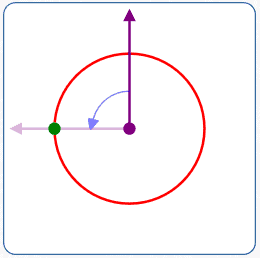
$r = 2$
$\theta = 90^\circ$
- A different placement of the polar axis
- Rotate the polar axis $\,90^\circ\,$ counterclockwise
- Move $\,2\,$ units in the direction of the rotated ray
Non-Uniqueness of Polar Coordinates
From Coordinate Pair to Point
In both rectangular and polar coordinates, a given coordinate pair specifies a unique point in the plane:
Rectangular Coordinates: once coordinate axes are positioned, each coordinate $\,(x,y)\,$ specifies a unique point in the plane.
Polar coordinates: once the polar axis is positioned, each coordinate $\,(r,\theta)\,$ specifies a unique point in the plane.
Good thing! You wouldn't want a coordinate pair specifying (say) one point on Monday, and a different point on Tuesday!
From Point to Coordinate Pair
However, when going from a point in a plane to a coordinate pair representing it—rectangular coordinates are simpler!
Rectangular coordinates: once coordinate axes are positioned, each point in the plane corresponds to a unique pair of real numbers $\,(x,y)\,.$
For rectangular coordinates, there is a one-to-one correspondence between points in the plane and coordinate pairs $\,(x,y)\,.$ For rectangular coordinates, it is as if the points in the plane and the pairs of real numbers $\,(x,y)\,$ are tied together with strings! Simple!
Polar coordinates: once the polar axis is positioned, each point in the plane has infinitely many coordinate pairs $\,(r,\theta)\,$ that can represent it.
Here are some examples:
Extra Revolutions
Radian measure for $\,\theta\,$:
$(\,r,\theta) = (r\,,\,\theta + 2\pi n)$
for all integers $\,n\,$
Degree measure for $\,\theta\,$:
$\,(r,\theta) = (r\,,\,\theta + n\cdot 360^\circ)$
for all integers $\,n\,$
If you sweep the angle one or more complete revolutions in either direction, you get to the same place!
Sweep to ‘Opposite’, then Go Backwards
Radian measure for $\,\theta\,$:
$\,(r,\theta) = \bigl(-r\,,\,\theta + (2n+1)\pi\bigr)$
for all integers $\,n\,$
Degree measure for $\,\theta\,$:
$\,(r,\theta) = \bigl(-r\,,\,\theta + (2n+1)\cdot 180^\circ\bigr)$
for all integers $\,n\,$
Sweep to ‘opposite’ the desired point, then go backwards!
For polar coordinates, it is as if each point in the plane has infinitely many strings coming from it, each going to a different polar coordinate representation for the point. Depending on the application, this may or may not be desirable.
Making the Polar Coordinate Representation Unique
There are different ways that you can restrict $\,r\,$ and $\,\theta\,$ to get a unique representation for each point in polar coordinates. Here are two of the most common ways:
(1) Radian measure for $\,\theta\,$ between $\,0\,$ and $\,2\pi\,$:
- $r\ge 0$
- $0 \le \theta \lt 2\pi$
- Represent the pole by only $\,(0,0)$
(2) Radian measure for $\,\theta\,$ between $\,-\pi\,$ and $\,\pi\,$:
- $r\ge 0$
- $-\pi \lt \theta \le \pi$
- Represent the pole by only $\,(0,0)$
There are corresponding restrictions for degree measure.
Note that unless you specify a unique representation for the pole, it would have ‘names’ $\,(0,\theta)\,$ for all possible values of $\,\theta\,.$